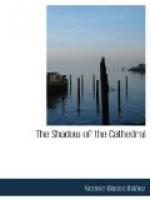In spite of his family considering this chapel as their own, the seminarist felt himself more attracted by that of Saint Ildefonso close by, which contained the tomb of the Cardinal Albornoz. Of all the great past in the Cathedral, that which excited his greatest admiration was the romantic figure of this warlike prelate; lover of letters, Spanish by birth, and Italian by his conquests. He slept in a splendid marble tomb, shining and polished by age, and of a soft fawn colour; the invisible hand of time had treated the face of the recumbent effigy rather roughly, flattening the nose, and giving the warlike cardinal an expression of almost Mongolian ferocity. Four lions guarded the remains of the prelate. Everything in him was extraordinary and adventurous even to his death. His body was brought back from Italy to Spain with prayers and hymns, carried on the shoulders of the entire population, who went out to meet it in order to gain the indulgences granted by the Pope. This return journey to his own country after his death lasted several months, as the good cardinal only went by short journeys from church to church, preceded by a picture of Christ, which now adorns his chapel, and spreading among the multitude the sweet scent of his embalming.
For Don Gil de Albornoz nothing seemed impossible; he was the sword of the Apostle returned to earth in order to enforce faith. Flying from Don Pedro the Cruel, he had taken refuge in Avignon, where lived exiles even more illustrious than himself. There were the Popes driven out of Rome by a people who, in their mediaeval nightmare, tried to restore at the bidding of Rienzi the ancient republic of the Consuls. Don Gil was not a man to live long in the pleasant little Provencal court; like a good archbishop of Toledo, he wore the coat-of-mail underneath his tunic, and as there were no Moors to fight he wished to strike at heretics instead. He went to Italy as the champion of the Church; all the adventurers of Europe and the bandits of the country formed his army. He killed and burnt in the country, entered and sacked the towns, all in the name of the Sovereign Pontiff, so that before long the exile of Avignon was again able to return and occupy his throne in Rome. The Spanish cardinal after all these campaigns, which gave half Italy to the Papacy, was as rich as any king, and he founded the celebrated Spanish college in Bologna. The Pope, well aware of his robberies and rapacity, asked him to give some sort of accounts. The proud Don Gil presented him with a cart laden with keys and bolts.
“These,” said he proudly, “belong to the towns and castles I have gained for the Papacy. These are my accounts.”
The irresistible glamour that a powerful warrior throws over a man physically feeble was strongly felt by Gabriel, and it was augmented by the thought that so much bravery and haughtiness had been joined in a servant of the Church. Why could not men like this arise now, in these impious times, to give fresh strength to Catholicism?




